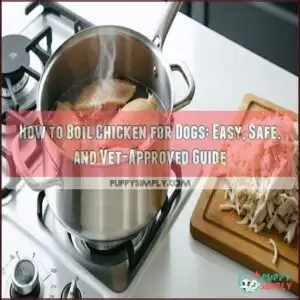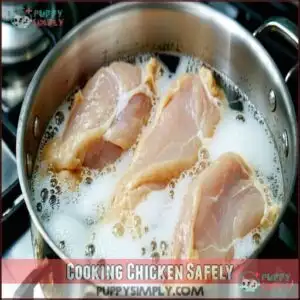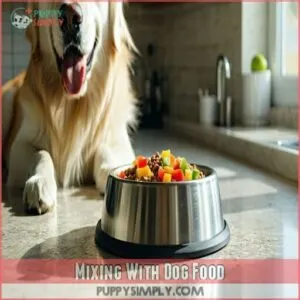This site is supported by our readers. We may earn a commission, at no cost to you, if you purchase through links.

Rinse the meat, place it in a pot, and cover it with water. Bring it to a boil, then reduce the heat and simmer for 12–15 minutes, or until the chicken’s fully cooked (165°F inside if you’re using a thermometer).
Let it cool, shred it into bite-size pieces, and skip the salt, spices, or oils—dogs don’t need seasoning! Store leftovers in the fridge for three days max.
It’s simple, safe, and sure to make tails wag. Want healthy serving tips? Keep reading!
Table Of Contents
- Key Takeaways
- Boiling Chicken Basics
- How to Boil Chicken
- Cooking Chicken Safely
- Health Benefits Explained
- Serving Boiled Chicken
- Feeding and Safety Precautions
- Frequently Asked Questions (FAQs)
- How do you boil chicken for dogs?
- How much boiled chicken to feed a sick dog?
- What is the correct way to boil chicken?
- Does boiled chicken help dogs’ stomach?
- How to boil a chicken for dogs?
- How long do you boil chicken for a dog?
- Can I boil chicken for my dog’s upset stomach?
- How do you cook chicken breast for a dog?
- Is it safe to boil chicken for a dog?
- How do you feed a dog boiled chicken?
- Conclusion
Key Takeaways
- Stick to boneless, skinless chicken, and boil it for 12–15 minutes until fully cooked at 165°F inside.
- Shred the chicken into bite-sized pieces and don’t add any seasoning, skin, or bones.
- Always prioritize food safety by cleaning tools, avoiding cross-contamination, and properly storing leftovers in airtight containers.
- Boiled chicken is great for digestion and perfect for upset stomachs but shouldn’t replace a balanced diet with carbs and other nutrients.
Boiling Chicken Basics
Boiling chicken for your dog is simple, but it starts with choosing the right ingredients and keeping things clean.
Choose fresh, boneless chicken and keep it clean—safe, simple, and perfect for your pup’s next delicious meal.
Stick to boneless, skinless chicken, make certain everything is fresh, and always maintain proper hygiene to keep your pup safe.
Choosing Boneless Chicken
When boiling chicken for dogs, always pick boneless chicken. Focus on chicken cut options like breasts or thighs, and choose organic if the budget allows.
Fresher chicken, indicated by a neutral smell, is ideal for better nutrition. Forget bones! Splinters are unsafe for pups.
The right choice guarantees safe, cost-effective dog food preparation without risking cooked chicken hazards. To guarantee safety, thorough cooking is essential.
Removing Skin and Bones
Once you’ve picked boneless chicken, it’s time for Safe Chicken Prep. Remove the skin to lower Skin Fat Content and avoid stomach troubles.
Check for chicken bones carefully—they’re a choking hazard and pose a Bone Splintering Risk.
Consider the convenience of purchasing pre-packaged options for easier preparation.
Using skinless chicken prevents issues and also keeps the meal’s Nutritional Impact high, perfect for boiling chicken for dogs.
Cleaning and Hygiene
Before boiling chicken for dogs, prioritize food safety.
Wash your hands well to avoid spreading bacteria. Clean all cooking utensils, pots, and bowls thoroughly—salmonella is no joke! Use hot, soapy water for surface sanitization, focusing on cutting boards.
Safe handling is key, so rinse chicken breasts under cold water. Proper bowl hygiene guarantees your dog stays happy and healthy.
How to Boil Chicken
To get perfectly cooked boiled chicken for your dog, follow these simple steps! Start with boneless, skinless chicken that’s fresh or fully defrosted—no one wants a frozen surprise.
Choose a medium-sized pot where the chicken can spread out, and cover it completely with water, leaving about 2 inches at the top.
Here’s a step-by-step guide to help you:
- Thaw the chicken fully beforehand for even cooking.
- Place the chicken in the pot and fill with water to the right level.
- Boil for 12–15 minutes, ensuring all pieces are cooked through.
- Check the internal temperature (165°F) with a meat thermometer.
- Cool the chicken for 20 minutes before shredding into bite-sized pieces.
That’s it—simple, safe, and nutritious!
Cooking Chicken Safely
Cooking chicken safely for your dog means focusing on proper handling, thorough cooking, and safe storage.
It’s all about preventing contamination and ensuring your pup gets fresh, fully cooked chicken every time.
Avoiding Cross-Contamination
Keeping your kitchen safe while boiling chicken means thorough cleaning and smart habits.
Wash your hands thoroughly before and after handling raw chicken—bacteria like salmonella can spread quickly. Use separate utensils and cutting boards for raw meat (this avoids cross-contamination).
Clean all surfaces with disinfectant, and store cooked chicken for dogs in sealed containers.
Thorough cooking eliminates bacteria like Salmonella and E. coli. Pet food safety starts here, and it is crucial for preventing cross-contamination and ensuring safe handling of food.
Using a Meat Thermometer
A food thermometer guarantees temperature accuracy and safe cooking methods when preparing chicken for dogs.
Insert it at the thickest part of the meat for proper placement. Safe temperatures should reach 165°F to confirm doneness.
Different thermometer types work, but digital ones are easiest. Make certain you have the right meat thermometer for accurate results.
Accurate cooking times protect your dog’s health, making cooked chicken for dogs both safe and nutritious.
Storing Cooked Chicken
After boiling chicken for your dog, proper storage is key to freshness and safety.
Use airtight containers to prevent spoilage. Consider using proper chicken containers for ideal preservation.
Follow these tips:
- Refrigeration Duration: Store chicken in the fridge for 3-4 days.
- Freezing Chicken: Freeze portions for up to 6 months.
- Safe Thawing: Defrost in the fridge overnight.
- Dog Food Storage Tip: Never leave boiled chicken unrefrigerated.
Reheating and Serving
Reheat boiled chicken gently using a microwave or stovetop, ensuring even warmth.
Aim for serving temperatures close to room temperature to avoid burns. Follow portion control based on your dog’s size.
Add broth for hydration or palatability boosters like diced carrots. Stick to proper cooking instructions and storage guidelines, keeping dog food safety tips in mind for happy, healthy meals!
Health Benefits Explained
Boiled chicken is packed with essential nutrients like protein, vitamins, and minerals that support your dog’s overall health.
Packed with protein and nutrients, boiled chicken supports your dog’s health, aids digestion, and satisfies picky eaters with its simple, wholesome goodness.
It’s also gentle on sensitive stomachs, making it a great option for pups with digestive issues or picky appetites, and is particularly beneficial for sensitive stomachs and digestive issues.
Nutritional Value and Benefits
Why is boiled chicken a top choice for your dog’s health?
It’s packed with protein for muscle growth, vitamins like B6 for energy, and minerals such as selenium for immunity.
As a lean protein source, it supports weight management while boosting digestive health.
Plus, boiled chicken or chicken broth for dogs can instantly stimulate a picky eater’s appetite, making it a great option for digestive health.
Addressing Digestive Issues
When your dog’s tummy is upset, offering a bland diet like chicken and rice can work wonders.
Boiled chicken is gentle on sensitive stomachs, while plain pumpkin benefits digestion by firming stool.
Yogurt probiotics can also help balance gut bacteria.
For dog diarrhea or vomiting, this soothing combo serves as a reliable remedy to quickly restore comfort.
Potential Allergies and Sensitivities
If your furry friend shows signs of a chicken allergy, like itching or diarrhea, it’s time to adjust.
Symptoms can mimic other issues, so a vet consultation is key.
Here’s how to handle it:
- Watch for allergy symptoms.
- Switch to limited ingredient dog food.
- Try alternative proteins like fish or turkey.
- Monitor for allergic reactions.
Balancing With Other Nutrients
Boiled chicken is a fantastic lean protein for dogs, but it’s not a complete meal.
To avoid vitamin deficiencies and maintain mineral balance, mix it with fiber sources like rice or veggies.
Dogs need rounded nutrition, including carbohydrates and fats, for energy, and supplementing chicken with diverse nutrients guarantees better long-term health and avoids straining kidneys from excessive protein, ensuring a complete meal.
Serving Boiled Chicken
Serving boiled chicken to your dog is simple, but it’s important to do it right for their health and safety.
Whether you’re using it as a meal topper, a training treat, or a standalone snack, make sure the portions suit their size and activity level.
Mixing With Dog Food
Adding boiled chicken to dog food can enhance flavor and nutrition.
Try a 2:1 ratio of plain rice and chicken for balance.
Follow these steps for easy mixing:
- Shred chicken into bite-sized pieces.
- Stir into dry or wet dog food.
- Include broth for hydration benefits.
- Test recipes to avoid picky eaters.
Enjoy customizing meals!
Using as a Standalone Meal
When feeding boiled chicken as a standalone meal, focus on portion control to support dog nutrition.
It’s perfect for upset stomachs or picky eaters, but not for daily use due to nutritional completeness concerns.
Monitor palatability—while cooking chicken for dogs is simple, long-term effects can leave them hooked.
Supplementing chicken with dog food guarantees balanced meals every time.
Incorporating Into Homemade Recipes
Looking to mix things up from plain boiled chicken? Try combining it with cooked rice, pumpkin, or dog-safe veggies for a balanced and tasty chicken recipe.
Homemade dog food benefits from variety, so think about adding apples or sardines for recipe texture and nutrient balance.
Make certain you’re cooking chicken thoroughly to eliminate harmful bacteria.
Keep it simple, wholesome, and flavorful—your pup will appreciate the recipe palatability!
Using as a Training Treat
When you’re teaching commands, boiled chicken works wonders as a high-value treat.
Keep treat size small to avoid overfeeding during frequent training sessions.
Dogs respond well to positive reinforcement, and the delicious reward keeps their tails wagging.
Mix boiled chicken with other treats for variety, ensuring it remains special.
The behavioral impact is noticeable—you’ll have a well-trained, happy companion!
Feeding and Safety Precautions
When feeding boiled chicken to your dog, it’s important to serve plain, skinless, and boneless pieces to avoid choking and digestive issues.
Always monitor portion sizes and your dog’s reaction, and consult your vet for guidance on maintaining a balanced diet.
Avoiding Chicken Bones and Skin
Chicken bones pose a serious bone splintering risk, potentially injuring your dog’s mouth or digestive tract.
Chicken skin, with its high fat content, can trigger digestion issues or even pancreatitis.
Stick to safe chicken prep by choosing boneless, skinless chicken. Removing skin and bones prevents choking hazards and guarantees boiled chicken stays a healthy, digestible option for your furry friend, ensuring a healthy choice.
Not Overfeeding or Underfeeding
Managing your dog’s diet is all about portion control and calorie calculation.
Overfeeding boiled chicken can lead to weight issues, while underfeeding may leave your furry friend lacking energy.
Adjust rations based on size, activity, and individual needs. Follow feeding guidelines or consult veterinary advice.
Balance chicken with dog food for a proper dog diet. Weight monitoring guarantees long-term health, and it’s crucial for maintaining your dog’s overall well-being through proper dog diet.
Monitoring Dog’s Weight and Health
Pay close attention to your dog’s weight, coat condition, energy levels, stool consistency, and appetite changes when feeding boiled chicken.
Weight fluctuations could mean too much or too little lean protein for dogs. A shiny coat and consistent stools reflect solid pet nutrition.
Watch for signs like lethargy or digestive trouble, especially when using chicken for a sick dog’s diet.
Regular checkups are essential for early detection of health issues.
Consulting a Veterinarian
Before shaking up your pup’s diet, check in with your vet. Professional guidance helps you avoid missteps, especially with breed predispositions or specific conditions.
Whether you’re trying a bland diet for dogs or a chicken rice remedy for an upset stomach, vets guarantee safety.
- Address allergies or sensitivities
- Confirm long-term diet balance
- Tailor dietary changes
- Prevent deficiencies
- Manage dog diarrhea remedies
Frequently Asked Questions (FAQs)
How do you boil chicken for dogs?
Start by using boneless, skinless chicken.
Cover it with water in a pot, boil for 12–15 minutes, ensuring it’s fully cooked at 165°F.
Let it cool, shred into small pieces, and serve.
How much boiled chicken to feed a sick dog?
Think of boiled chicken as a warm hug for your dog’s tummy.
Start with small portions—about 1-2 tablespoons for every 10 pounds of weight per meal.
Gradually increase, monitoring for any adverse reactions.
What is the correct way to boil chicken?
Use boneless, skinless chicken, cover it with water in a pot, and boil for 12-15 minutes until fully cooked.
Cool it, shred into small pieces, and check it’s done by cutting inside to ensure the chicken is properly cooked.
Does boiled chicken help dogs’ stomach?
They say, "What’s good for the goose is good for the gander,"
and boiled chicken truly soothes a dog’s upset stomach.
Its gentle, bland protein calms digestion, reduces irritation, and restores balance naturally.
How to boil a chicken for dogs?
Boil boneless, skinless chicken in enough water to cover it, cooking for 12-15 minutes until fully done (165°F inside).
Let it cool, shred into small dog-friendly pieces, and skip any seasonings entirely.
How long do you boil chicken for a dog?
You should boil chicken for dogs for about 12 to 15 minutes, making sure the internal temperature hits 165°F.
Cut into it to check that it’s fully cooked—no pink spots allowed!
Can I boil chicken for my dog’s upset stomach?
An ounce of prevention is worth a pound of cure—boiled chicken can soothe your dog’s upset stomach.
Its bland, easily digestible nature helps calm digestion.
Just skip the seasoning, skin, and bones.
How do you cook chicken breast for a dog?
Start by using boneless, skinless chicken breasts.
Place them in a pot, cover with water, and bring to a boil.
Cook for 12-15 minutes, then cool.
Shred into dog-safe pieces before serving.
Is it safe to boil chicken for a dog?
Think of boiled chicken as a blank canvas for your dog’s diet—safe, simple, and versatile.
It’s gentle on their stomachs, easy to digest, and perfect when prepared plain without risky additives like salt or spices, making it a blank canvas for their diet.
How do you feed a dog boiled chicken?
Feed your dog boiled chicken by shredding it into small, bite-sized pieces.
Serve plain or mix it with rice or vegetables.
Keep portions moderate, avoid seasoning, and refrigerate leftovers for up to three days.
Conclusion
Boiling chicken for dogs isn’t just easy—it’s a healthy, vet-approved way to treat your pup.
By sticking to boneless, skinless options and avoiding seasoning, you’re giving your dog a protein-packed meal that supports digestion and overall health.
Remember to cook chicken thoroughly, shred it into bite-sized pieces, and store leftovers properly for safety.
Whether you mix it with kibble, use it for training, or serve it solo, boiled chicken’s simplicity and benefits can’t be beat!
- https://www.heartofthecanine.com/blogs/blog/how-to-boil-chicken-for-dogs-an-easy-guide-for-pet-parents
- https://www.greatpetcare.com/dog-nutrition/how-to-boil-chicken-for-dogs/
- https://westloopvet.com/blog/blog-how-to-boil-chicken-for-dogs/
- https://www.raisedrightpets.com/blog/how-to-boil-chicken-for-dogs/?srsltid=AfmBOoqmurw12DL3A7qC4E4JawefLcc6k9-5WtpWP7aE-OdKP_jFUmYu
- https://www.allrecipes.com/recipe/139453/lucky-and-rippys-favorite-dog-food/














